#sang keun kim
Explore tagged Tumblr posts
Text






F r o g s
#qui se cache dans la grotte by Sang-Keun Kim#La grenouille qui aimait le rouge by Eve Gomy#Le pire des chevaliers by Anna Kemp and Sara Ogilvie#La chanson de Bernardo by Mk Smith Despres and Hyewon Yum#Enfin tranquille by Barroux#I love frogs#hope this makes your day better
1 note
·
View note
Text
Introduction to Characters:
It will be useful for those who want to get an image of how the characters will look like, so i got referential images for them:
(Yes i did a whole casting for it)
Baek Yujin - Baek Ji Heon
She's the daugther of Chulsoo and Eunseo, the main protagonist of this story as her box will reveal secrets that shouldn't have been known...
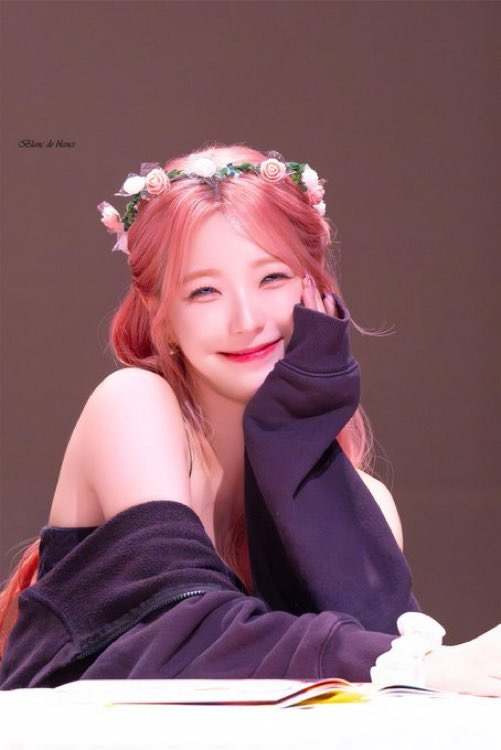
Im Hayoung - Lee Na Gyung
A rookie idealistic police detective that always wants to get until the last consequences of any case she's in, even if it doesn't means good things most of the time, she'll be in charge of the case of Yujin along with her "Cap" Jo Kyun Sang.

Yoon Seonwoo - Ahn Dong Goo
He's married to Baek Mijoo, Yujin's sister.
He's the prototype of excellent prosecutor, receiving many awards and being the best paid among all prosecutors in the Nonhyeon-dong Office, in Gangnam, Seoul.

Ahn Jinsoul - Kang Hye Won
Friend of Baek Yujin since they attended to school, she likes Yujin but she prefers to keep it secret and convinces herself that she doesn't likes Yujin and focuses in any other Gangnam rich men.

Baek Chulsoo - Son Jong Hak
Father of Baek Yujin and Mijoo, husband of Kang Eunseo.
He's the president and third generation heir of the Chunhwa Company, a large chaebol that specialises in airlines.

Kang Eunseo - Jin Kyung
Mother of Baek Yujin and Mijoo, wife of Baek Chulsoo.
She's a very prejudiced and arrogant woman. Usually likes to brag about Mijoo's achievements, since for her Yujin is nothing but an "accident" as she ain't as successful as Mijoo.
Used to be an k-pop idol for the 1st generation group "September". (Will be seen in the lore of the story)

Baek Mijoo - Ha Yoon Kyung
Older sister of Baek Yujin and daughter of Baek Chulsoo and Kang Eunseo.
Mijoo is a successful businesswoman that usually would have the best grades in school and would be the best student in every university or master degree she would take.
Even though she doesn't has plans on taking Chunhwa's Company, which is Chulsoo's company, he still keeps the hope his daughter thinks to get it.
She's the favorite daughter of her mom and also is the most loved by her father, and well... of her husband too.

Jung Jihun - Lee Pil Mo
Chief Prosecutor of Gangnam District.
Has a really bad mood everytime and usually yells at his juniors, his marriage is about to end and his work situation isn't really better after Yujin's case comes up.

Kim Juhwan - Kim Kwang Gyu
He is the chief judge of the Seoul court.

Lee Haneul - Lee Da Hee
She's the attorney of the Ahn Family.
She studied abroad half of her life, featuring the top universities in Korea and the USA.
Received many awards for her job as a lawyer and was part of many important law firms before being a private attorney.

Extra Characters or Guests:
Ahn Seul - Jang Hye Jin
Mother of Ahn Jinsoul. Married to a private husband which is rumoured to be a millionaire foreigner.
Used to be an actress during the first eras of korean cinema.

Priest - Shin Jung Keun
He'll marry Baek Mijoo and Yoon Seonwoo.

Day6
Baek Yujin's favourite band, might appear in concerts or in a reference to some of their songs which are crucial to understand some scenes.

AKMU & Blue.D/MINO
Same case as Day6, but being even more referenced due to specific songs:
AKMU: Fish in the Water
Blue.D/MINO: Nobody
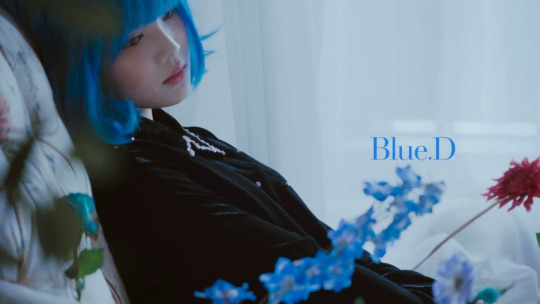

As this story is developing, some other characters might be added, so keep tuned to this story!
#story#kdrama#poetry#poem#literature#original poem#original story#kpop#fromis 9#akmu#day6#day6 even of day#hyewon#kang hyewon#izone#izone hyewon#ive#newjeans#illit#le sserafim
12 notes
·
View notes
Text
the full timeline of burning sun (and goo hara)
2015 - 2017 crimes committed pre-burning sun
13 december 2015: seungri throws a birthday party for himself in shanghai with his friends and investors. here, he requests for girls that "give it good" for his investors (bbc)
______________________________________________________________
2016 jung joon young (jjy)'s molka (secret recording) crime
january 2016 - jjy, choi jung hoon (cjh) went to a ski resort with 2 others. at 7.39pm, kim sent a video to seungri (who wasnt present) about sexually assaulting a victim at the resort (bbc) *note: seungri was in japan for the big bang made concert tour from jan 9 - jan 11
february 2016 - jjy's ex gf filed a police report about him secretly recording a sexual video of her
15 march 2016 - jjy, cjh, park and kim assaulted a victim in daegu (bbc)
16 march 2016 - jjy had a fan meeting, one day after assaulting a victim
22 august 2016 - police requested that the private forensics company write a report to the police that "jjy's phone is unable to be restored and there are no data recovered"** 23 september 2016 - exclusive article released by reporter park hyo sil about the crime. for the next 3 years, park hyo sil will be a victim of a public witch hunt, having 2 miscarriages from the stress
06 october 2016 - jjy was cleared on all crimes. public opinion was in favor of him.
**today, we know that the private forensic company had secretly recovered all the files from his phone, and kept in 3 USBs. it contains data from 2015 - 2016. in 2019, a female from the company dropped of the 3 USBs at an attorney's office, who later contacted reporter kang kyung yoon. this will be the break of the burning sun case in 2019
______________________________________________________________
9 december 2017 - seungri rented an entire resort for his birthday party in palawan, philippines. here, he invited investors that would help him in his opening of the burning sun club. (bbc)
23 february 2018 - burning sun opened
2018 goo hara's assault from her boyfriend
10 september 2018 - goo hara has lunch with her manager and a male colleague for an upcoming schedule, without informing her boyfriend, choi jeong beom (cjb). cjb was known to be very jealous and overprotective of goo hara meeting other men, even if it is totally platonic and for business
13 september 2018 - choi jeong beom assaults goo hara 12.30am: cjb enters goo hara's home, drunk, and assaults goo hara 1.26am: cjb emails dispatch to provide them with "goo hara tip" 1.39am: cjb's friend helps to move cjb's luggage out of goo hara's house 2.04am: cjb sends goo hara their sex tape 2.21am: goo hara kneels to cjb in front of her elevator 2.22am: goo hara follows cjb down to his car 2.23am: cjb sends goo hara a second video of their sex tape, while loading his luggage into his car 3.30am: cjb called the police and was dispatched 4.21am: cjb emails dispatch a 2nd time about this "goo hara tip"
______________________________________________________________
the rise and fall of burning sun
24 november 2018 - club-goer kim sang kyo was allegedly physically assaulted by burning sun staff members when he was trying to save a victim
28 january 2019 - news reports about the assault at burning sun are released
26 february 2019 - reporter kang kyung yoon releases the kakao chat messages between the perpetrators
14/15 march 2019 - goo hara privately contacts reporter kang kyung yoon, telling her that she wants to help with the investigation since she is a victim of revenge porn. goo hara calls choi jung hoon (cjh), who were close friends since their trainee days. she persuaded cjh to tell the reporter who the police officer that was covering up their tracks were. the police officer was revealed by cjh to be yoon kyu keun, who had worked in the president's residence. (bbc)
16 march 2019 - articles about police officer yoon kyu keun are released, less than 48 hours after goo hara called cjh
14 october 2019 - f(x)'s sulli, goo hara's close friend, commits suicide 24 november 2019 - goo hara commits suicide
14 january 2020 - someone steals goo hara’s safe in her house
jung joon young: 5 years of prison choi jung hoon: 2 years of prison seungri: 18 months of prison
______________________________________________________________
others related to this case
people that were part of the group chats and admitted to watching the videos illegally filmed, but had not actively sexually assault anyone
beast/highlight yong jun hyung
cnblue lee jong hyun
soloist roy kim
soloist eddy kim
hyuna and yong junhyung relationship
2009 - 2010: 4minute hyuna and goo hara became close friends while filming invincible youth 2011 - march 2013: yong junhyung and goo hara's relationship may 2016 - november 2022: pentagon edawn/dawn/kim hyojong and hyuna's relationship january 2024 onwards - yong junhyung and hyuna dating and getting married
#burning sun#big bang#seungri#jung joon young#jjy#ft island#choi jung hoon#goo hara#kara#beast#highlight#yong jun hyung#4 minute#hyuna#pentagon#edawn#dawn#kim hyo jung
31 notes
·
View notes
Text
Especial KRP — Sobrenomes Coreanos
Cansado de Lee? Kim? Seo? Song? Choi? Hwang? Park? Abaixo do "Read More" você vai encontrar alguns sobrenomes mais incomuns que pode usar em seus personagens coreanos.

Ah, A (아 - A)
Ae (애 - É)
Ban, Bahn, Van, Vahn, Pan, Pahn (반 - Ban)
Beon, Bun, Buhn, Veon, Vun, Vuhn (번 - Bón)
Beom, Bum, Buhm, Veom, Vum, Vuhm (범 - Bóm)
Bo, Vo (보 - Bô)
Bok, Vok (복 - Bôc)
Bong, Vong (봉 - Bông)
Boo, Bu, Voo, Vu (부 - Bú)
Bi, Vi, Bee, Vee (비 - Bi)
Bin, Been, Bean, Vin, Veen, Vean (빈 - Bin)
Bing, Beeng, Ving, Veeng (빙 - Bing)
Da (다 - Dá)
Dam (담 - Dam)
Dan (단 - Dan)
Dang (당 - Dang)
Dae, Dai (대 - Dé)
Dok, Dock (독 - Dôc)
Dokgo, Dokko (독고 - Docô)
Don (돈 - Dôn)
Dong (동 - Dông)
Dongbang (동방 - Dôngbâng)
Deung (등 - Dûng)
Deungjeong, Deungjung (등정 - Dûngdjóng)
Eogeum, Uhgeum, Ugeum (어금 - Ógûm)
Eun (은 - Ûn)
Eum (음 - Ûm)
Hak, Hahk (학 - Rác)
Hae (해 - Ré)
Hyeong, Hyung, Hyoung (형 - Rióng)
Ho, Hoh (호 - Rô)
Hwa, Hwah (화 - Ruá)
Hwangmok (황목 - Ruangmôk)
Hwangbo (황보 - Ruangbô)
Hoo, Hu (후 - Ru)
Ja, Jah (자 - Já)
Jeom, Jum (점 - Djóm)
Je, Jeh (제 - Djê)
Jegal, Jekal (제갈 - Djegál)
Jeo, Juh (저 - Djó)
Jong (종 - Djông)
Jwa, Joa, Jua (좌 - Djuá)
Jeung (증 - Jûng)
Kangjeon, Kangjun, Gangjeon, Gangjun (강전 - Gangdjón)
Ka, Ga (가 - Ga)
Kal, Gal (갈 - Gal)
Kam, Gam (감)
Kan, Gan (간 - Gan)
Kae, Gae (개 - Gué)
Kyun, Kyeon, Kyoun, Gyun, Gyeon, Gyoun (견 - Guión)
Kyung, Kyeong, Kyoung, Gyung, Gyeong, Gyoung (경 - Guióng)
Kye, Gye (계 - Guiê)
Kok, Gok (곡 - Gôc)
Kwan, Gwan (관 - Guân)
Kwok, Gwok (궉 - Guóc)
Kyo, Gyo (교 - Guiô)
Kuk, Guk, Kook, Gook, Kuck, Guck (국 - Guc)
Kung, Koong, Gung, Goong (궁 - Gung)
Kwok, Gwok, Kweok, Gweok (궉 - Guóc)
Keun, Geun (근 - Gûn)
Keum, Geum (금 - Gûm)
Ki, Gi, Kee, Gee (기 - Gui)
Kil, Gil (길 - Guil)
Lin, In, Rin, Leen, Een, Reen (인 - In)
Man, Mahn (만 - Man)
Mangjeol, Mangjul (망절 - Mangdjól)
Mae (매 - Mé)
Maeng (맹 - Méng)
Myung, Myeong, Myoung (명 - Mióng)
Mo, Moh (모 - Mô)
Mok, Mock (목 - Môc)
Myo (묘 - Miô)
Moo, Mu (무 - Mu)
Mubon, Moobon (무본 - Mubôn)
Muk, Muck, Mook, Moock (묵 - Muc)
Mi, Mee (미 - Mi)
Nan (난 - Nan)
Namgoong, Namgung, Namkoong, Namkung (남궁 - Namgung)
Nang (낭 - Nang)
Nae (내 - Né)
Noi, Nwe (뇌 - Nê)
Ok, Ock (옥 - Ôc)
On, Ohn (온 - Ôn)
Ong (옹 - Ông)
Pan, Pahn (판 - Pan)
Paeng (팽 - Péng)
Pyeon, Pyun, Pyuhn (편 - Pión)
Pyeong, Pyung, Pyuhng (평 - Pióng)
Po, Poh (포 - Pô)
Pyo (표 - Piô)
Pung, Poong (풍 - Pung)
Pi, Pee (피 - Pi)
Pil, Fil, Peel, Feel (필 - Pil)
Ra, La, Rah, Lah (라 - Lá)
Ran, Lan (란 - Lan)
Rang, Lang (랑 - Lang)
Ryeo, Ryuh, Lyeo, Lyuh (려 - Lió)
Roe, Loe, Roi, Loi, Rwe, Lwe (뢰 - Lê)
Sa, Sah (사 - Sá)
Sakong, Sagong (사공 - Sagông)
San, Sahn (산 - San)
Sam, Sahm (삼 - Sam)
Sang, Sahng (상 - Sang)
Seomun, Seomoon, Suhmun, Suhmoon, Sumun, Sumoon (서문 - Sómún)
Seonu, Seonwu, Seonwoo, Seonoo, Sunu, Sunwu, Sunwoo, Sunoo (선우 - Sónú)
Seob, Sub, Seop, Sup, Suhb, Suhp (섭 - Sób)
Sobong (소봉 - Sobông)
Soo, Su (수 - Su)
Sun, Soon (순 - Sun)
Seung (승 - Sûng)
Si, Shi, Xi, See, Shee, Xee (시 - Xi)
Tak, Tahk (탁 - Tác)
Tan, Tahn (탄 - Tan)
Tang, Tahng (탕 - Táng)
Tae (태 - Té)
Uh, Eo, Eoh (어 - Ó)
Wan, Wahn (완 - Uán)
Wang, Wahng (왕 - Uáng)
Wun, Un, Woon, Oon (운 - Un)
Wi (위 - Uí)
Ya, Yah (야 - Iá)
Yeop, Yeob, Yup, Yub, Yuhp, Yuhb (엽 - Iób)
Yeong, Young, Yung (영 - Ióng)
Ye, Yeh (예 - Iê)
Yo (요 - Iô)
Yong (용 - Iông)
Yook, Yuk (육 - Iúk)
37 notes
·
View notes
Note
Hello! Good morning or good night, everyone. I need some advice regarding old Korean actors and actresses who can portray a grandpa and a grandma. Could you pretty please help me?
Um Aing-ran (1936) Korean.
Kim Young-ok (1937) Korean.
Kim Yong-rim (1940) Korean.
Kim Hye-ja (1941) Korean.
Kang Boo-ja (1941) Korean.
Na Moon-hee (1941) Korean.
Park Jeong-ja (1942) Korean.
Ban Hyo-jung (1942) Korean.
Sunwoo Yong-nyeo (1945) Korean.
Youn Yuh-jung (1947) Korean.
Jung Jae-soon (1947) Korean.
Lee Hyo-choon (1950) Korean.
Go Doo-shim (!951) Korean.
Yoon Mi-ra (1951) Korean.
Yang Hee-kyung (1954) Korean.
Moon Sook (1954) Korean.
Kim Hae-sook (1955) Korean.
Ye Soo-jung (1955) Korean.
Lee Kyung-jin (1956) Korean.
Kim Bo-yeon (1957) Korean.
Kim Hye-ok (1958) Korean.
Sunwoo Eun-sook (1959) Korean.
Shin Shin-ae (1959) Korean.
Im Ye-jin (1960) Korean.
Cha Hwa-yeon (1960) Korean.
Choi Min-sik (1962) Korean.
and:
Lee Soon-jae (1934) Korean.
Shin Goo (1936) Korean.
Lee Ho-jae (1941) Korean.
Jeon Moo-song (1941) Korean.
Park In-hwan (1945) Korean.
Jang Hang-sun (1947) Korean.
Baek Yoon-sik (1947) Korean.
Lee Jang-hee (1947) Korean.
Jung Dong-hwan (1949) Korean.
Yoon Joo-sang (1949) Korean.
Lee Young-ha (1950) Korean.
Ahn Sung-ki (1952) Korean.
Lee Deok-hwa (1952) Korean.
Jang Gwang (1952) Korean.
Jeon Gook-hwan (1952) Korean.
Lee Kye-in (1952) Korean.
Do Gyeong Lee (1953 Korean.
Moon Sung-keun (1953) Korean.
Kim Chang-wan (1954) Korean.
Gi Ju-bong (1955) Korean.
Park Jin-yeong (1955) Korean.
Shin Cheol-jin (1956) Korean.
Yoo Dong-geun (1956) Korean.
Choi Jung-woo (1957) Korean.
Kim Kap-soo (1957) Korean.
Song Seung-hwan (1957) Korean.
Park Sang-won (1959) Korean.
Kim Yon-ja (1959) Korean.
Lee Geung-young (1960) Korean.
Chun Ho-jin (1960) Korean.
Kim Byeong-ok (1960) Korean.
I hope this helps! ✨
4 notes
·
View notes
Text
Which Moon representative arranged anti-communist terrorist funding in 1978?
Declassified FOIA documents confirm the high level of involvement of the Unification Church in terroristic anti-communist operations throughout the 70s. According to the documents, several representatives of the Unification Church were in 1978 meetings with CORU (Coordination of United Revolutionary Organizations), a CIA-backed anti-Castroist terrorist organization known for assassinations and bombings, including in the U.S. One Unification Church member disclosed that the church had funded 85% of the World Anti-Communist League (WACL), an anti-communist organization known for backing, organizing, and funding death squads throughout the world. This representative understood the violent and terrorist nature of such operations, stating (and reiterating) that "Rev. Moon desires to discreetly establish and finance a network of radical anti-communist groups around the world to fight the communists inasmuch as Moon fears the United States will withdraw from Korea and expose Korea to the North Korean communists."
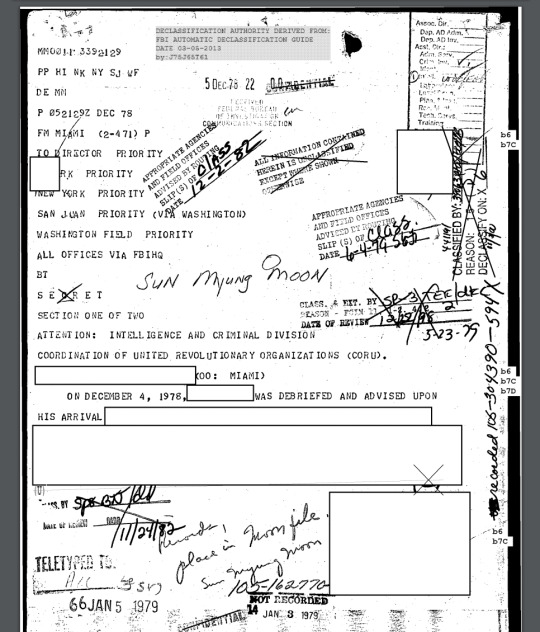
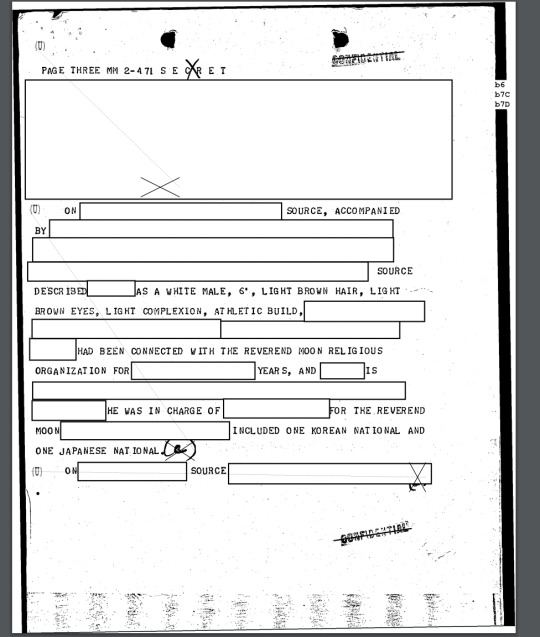
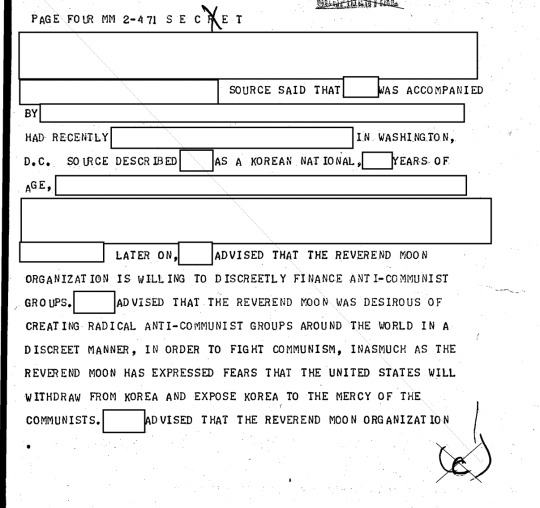
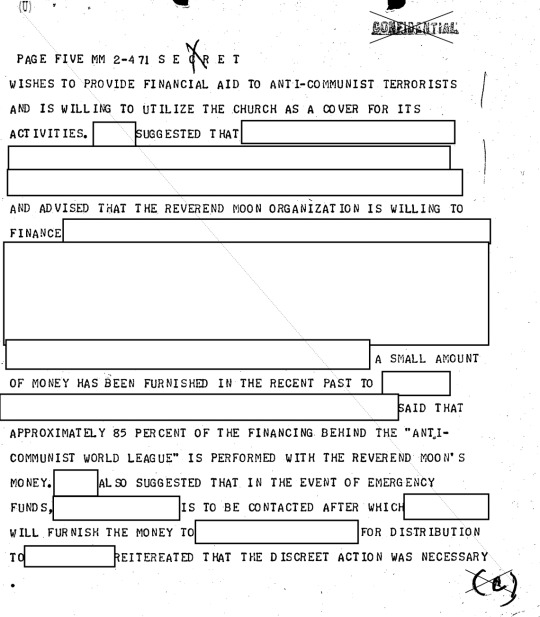
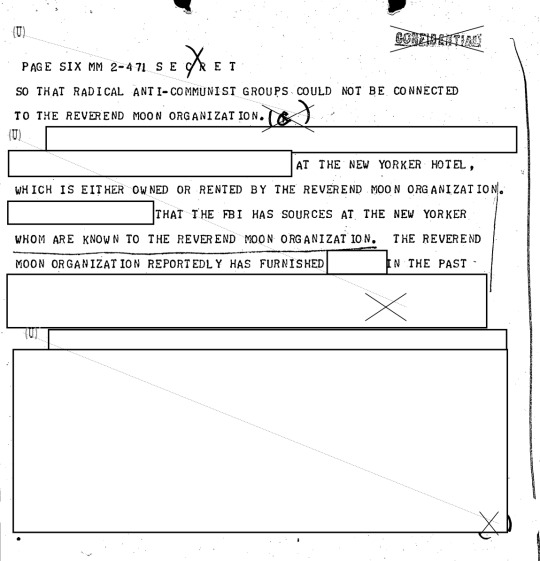

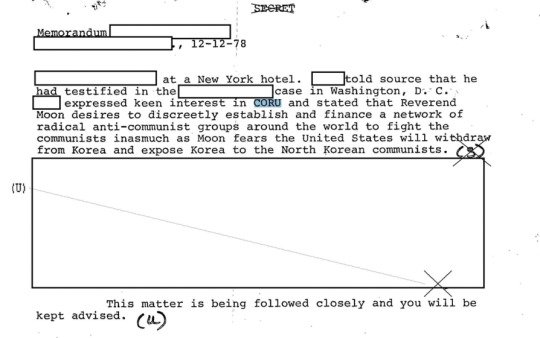
Many have wondered who could this mysterious member be? Some have speculated it was Paul Perry (Paulo-Juarez Pereira) but the physical description (white male, 6', light brown hair, light brown eyes, light complexion, athletic build) does not match, as Perry is shorter, and Perry/Pereira was not in charge of any major organization in 1978. Though it is redacted and says "in charge of ______ affairs," the missing word is likely "political."

It's worth noting that this physical description does match one individual: Neil Salonen, who served as the President of Unification Church USA from 1972 to 1980, when he was succeeded by Mose Durst, and head of its primary political arm in the U.S. at the time, the Freedom Leadership Foundation.
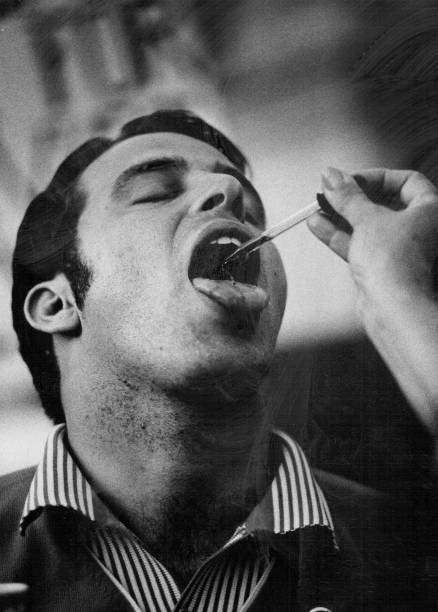
▲ Neil Salonen He was also a member for eleven years at this point.

Salonen had also visited FBI HQ earlier that year, on January 26, 1978, to "explain for the record the activities and purpose of the [Unification Church of America] and to enlighten the FBI and provide a clear picture of that church for future reference." He explained various UC-connected organizations and provided the agents with church publications for reference. The agents noted that he was very courteous. He raised concern over the 250+ cases of adult members being forcibly taken by their parents or by hired “deprogrammers,” and noted that the FBI investigating such cases often didn't interview victims directly, instead trusting the parents’ assurances that their adult children were “safe at home.” Salonen argued that many of these individuals were being held under duress and he urged the FBI to ensure personal interviews in the future.
Salonen’s positions within the church put him at the heart of its political maneuvering, making it possible for him to go to the FBI HQ and be given ample time to thoroughly defend the UC. In the 70s, Salonen found himself leading the National Prayer and Fast Committee during the Watergate crisis, being invited by Bob Dole to his office in 1976 to discuss "concerned parents" and "former members" and the problems of deprogramming, as well as cooperating directly with the KCIA (including working with Moonie and KCIA officer Kim Sang Keun) in organizing anti-Japanese demonstrations in 1974 throughout the U.S. Former members who took part in this march "recalled that while the demonstrators were near the Korean Embassy, someone came out of the Embassy and spoke to Neil Salonen. Shortly afterwards Salonen called the demonstration off."
It has not been confirmed that this individual is Neil Salonen, but as somebody who directly coordinated church campaigns and efforts with the direction of the KCIA, it is likely that he knew of and affirmed the UC's funding of anti-communist death squads.
______________________________
Related
United States Congressional investigation of UC
In order to rule the world, Sun Myung Moon had to start with Korea.
“Moon used to play golf regularly with Kim Jong-pil”
The Moon Organization and the KCIA – ‘Privatizing’ covert action
Paul Perry, or Paulo-Juarez Pereira, a CIA-Connected Moonie
September 14, 1974: Moonies Ordered to Throw Eggs at Japanese Embassy
World Domination – Sun Myung Moon’s many attempts ended in failure
The Unification Church and KCIA: Some Notes on Bud Han, Steve Kim, and Bo Hi Pak
In Bolivia, Moon disciple Tom Ward and the former Hitler SS Officer, Klaus Barbie were often seen together
#kcia#parapolitical#politics#unification church#freedom leadership foundation#flf#neil salonen#members#leadership#anti-communism#death squads#wacl#world anti-communist league#fbi
3 notes
·
View notes
Text
Korean Art London
Following on from this post on 08/07/2023, I finally made it to the exhibition yesterday and am posting some of the art that caught my eye as I walked round.
Epidermis World: Love 67, Ji Young Hong

Lover Boy, Ha Jin Lee

Boundless Love, J Ryu
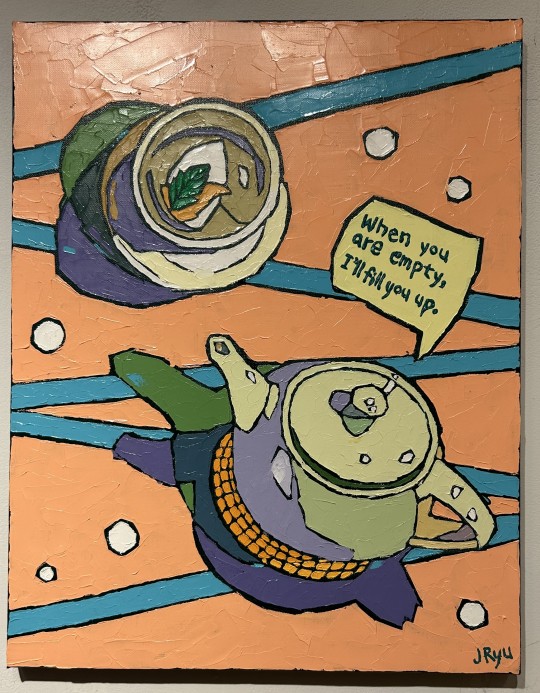
Hojakdo by the Fireplace & Every Moments of You - 1 by Na Ri Choi

Human, Human, Human by Jin Hyun Nam
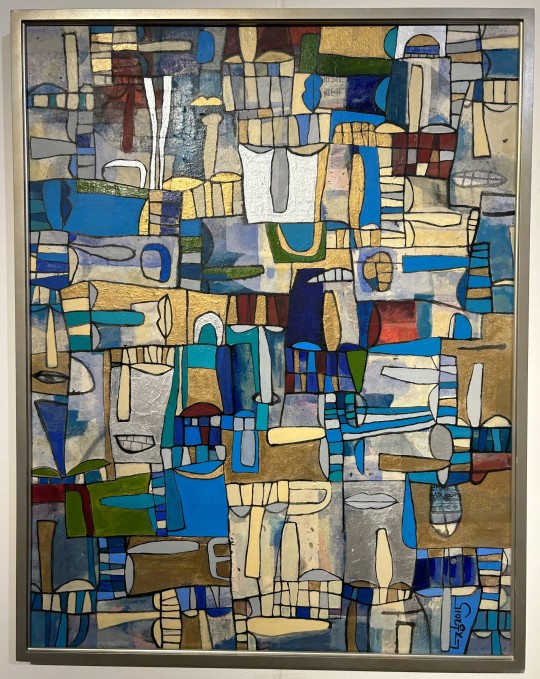
The Korean Five had a separate space as artists selected to showcase the highest level of contemporary South Korean painting. These were Soon Young Yang, Sang Woon Nam, Min Chan Kim, Jun Won Lee and Lee K.
Sang Woon Nam's Blue Moon series includes tiny hard to spot details which add to the intrigue of the paintings.
Blue Moon, Sang Woon Nam
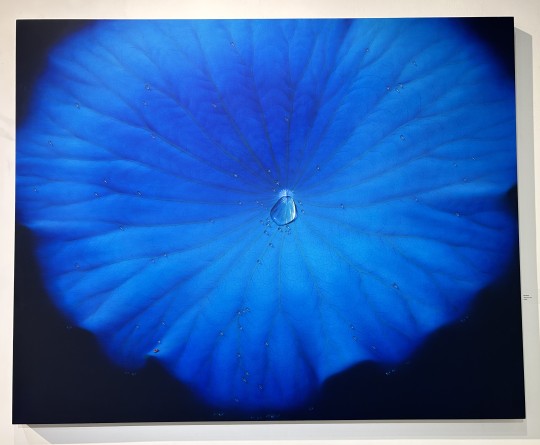

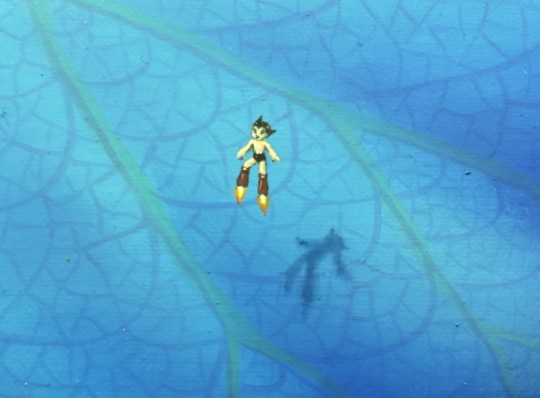
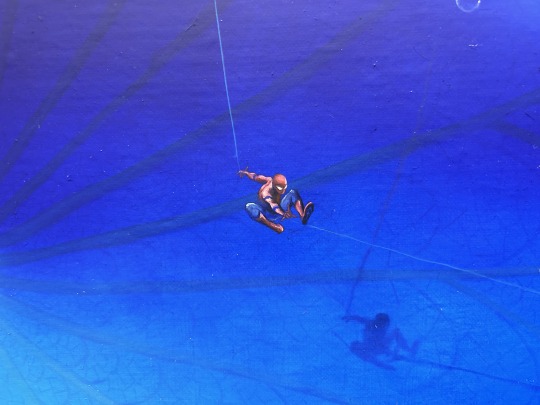
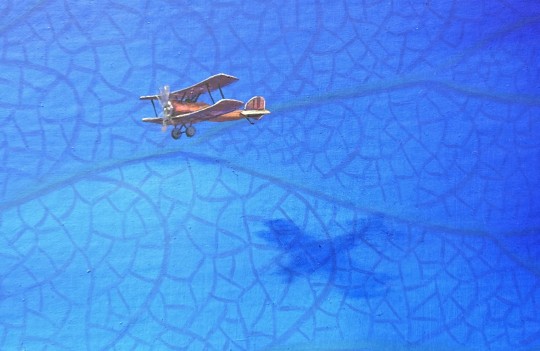
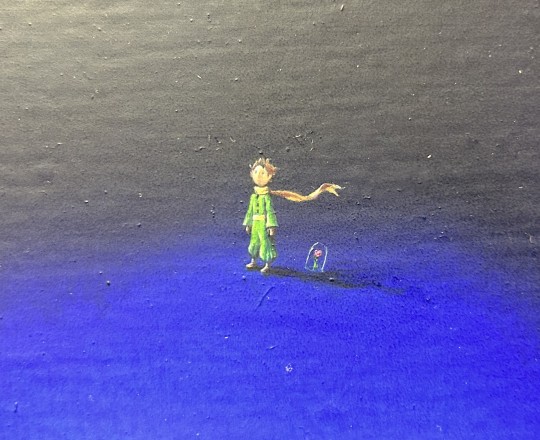
Finally, Lee K exhibited some of his striking portraits...
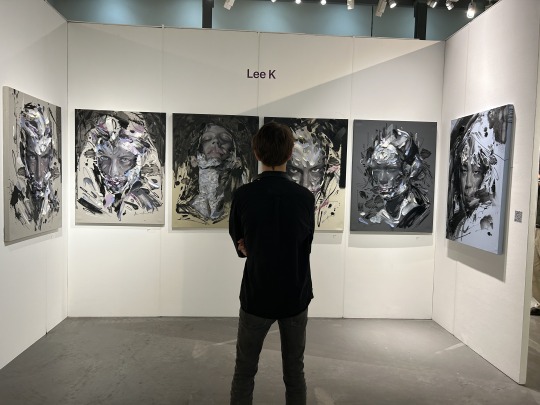
...including this one inspired by none other than Park Jimin.
Untitled#J2219, Lee K
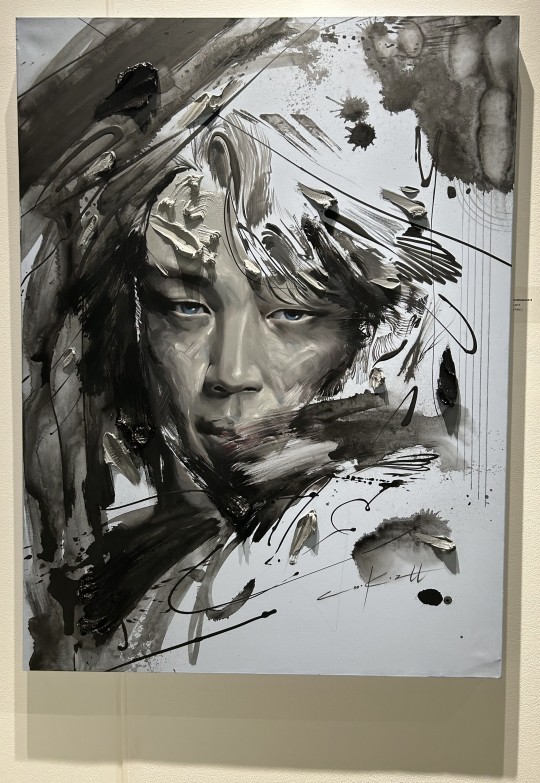
I really enjoyed seeing what's going on in the world of South Korean contemporary art. I also found out that everyone who bought tickets for the Korean Art London show can also get free entry to the Yun Hyong-Keun exhibition currently on in Hastings if they go before the 22nd July. Bummed out that I won't be able to take advantage of this offer but I do plan to head to the South Coast sometime before the beginning of October to see this retrospective of RM's favourite artist
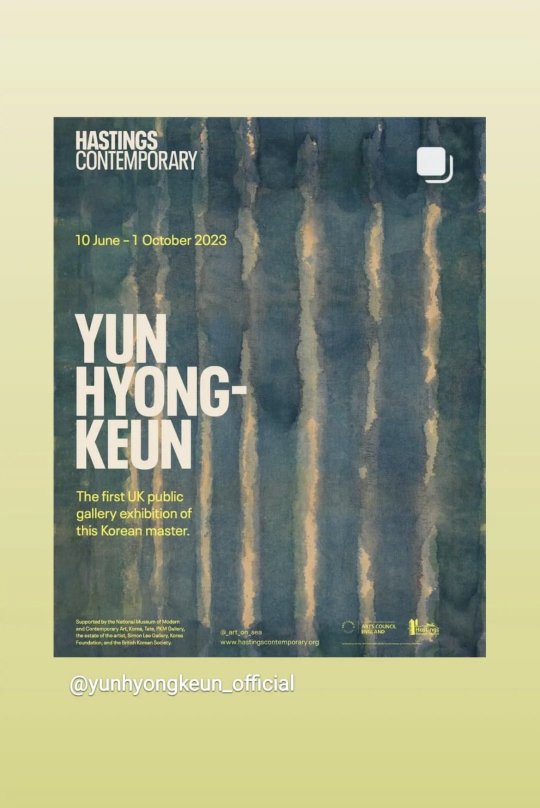
Post Date: 20/07/2023
52 notes
·
View notes
Text
Dongbang Medical - Hành trình lấy lại vóc dáng
Từ một doanh nghiệp y tế hàng đầu Hàn Quốc đến đế chế thẩm mỹ toàn cầu
Viện thẩm mỹ DongBang, một trong những cái tên uy tín nhất trong ngành thẩm mỹ hiện nay, có một hành trình phát triển đầy ấn tượng. Nguồn gốc của DongBang bắt đầu từ năm 1988, khi Tập đoàn DongBang Medical Hàn Quốc được thành lập dưới sự dẫn dắt của Chủ tịch Kim Keun Sik. Ngay từ những ngày đầu, DongBang đã khẳng định vị thế của mình trong lĩnh vực y tế và chăm sóc sức khỏe cộng đồng tại Hàn Quốc, được biết đến như một trong những tập đoàn hàng đầu trong Top 10.
Vượt qua thách thức, vươn mình ra thế giới
Cuộc khủng hoảng kinh tế châu Á năm 1997 đã gây ra những tác động sâu sắc đến nền kinh tế Hàn Quốc, khiến hàng nghìn doanh nghiệp phải đối mặt với nguy cơ phá sản. Tuy nhiên, DongBang Medical đã chứng minh được sức mạnh và sự kiên cường của mình. Thay vì gục ngã, tập đoàn đã quyết liệt tái cơ cấu, đổi mới mô hình kinh doanh và nhanh chóng vươn mình ra thị trường quốc tế. Năm 1999, DongBang đã có mặt tại nhiều quốc gia phát triển như Mỹ, Đức, Anh, Pháp...
Tăng trưởng bùng nổ và vinh danh quốc tế
Đến năm 2008, DongBang Medical đạt được những thành tựu đáng kể. Tập đoàn được Tổng thống Hàn Quốc – Lee Myung Bak vinh danh là một trong những doanh nghiệp có đóng góp lớn nhất vào sự nghiệp phát triển kinh tế của đất nước. Sự kiện này đánh dấu một cột mốc quan trọng trong quá trình phát triển của DongBang. Cùng năm đó, mạng lưới chi nhánh của DongBang đã mở rộng lên đến 32 chi nhánh trên toàn cầu.
Mở rộng thị trường và tập trung vào thẩm mỹ
Song song với việc phát triển các dịch vụ y tế, DongBang cũng không ngừng mở rộng hoạt động trong lĩnh vực thẩm mỹ. Với hệ thống bệnh viện thẩm mỹ 5 sao hiện đại, DongBang đã cung cấp cho khách hàng những dịch vụ làm đẹp chất lượng cao.
Đến Việt Nam và chinh phục thị trường
Nhận thấy tiềm năng lớn của thị trường Việt Nam, năm 2023, DongBang chính thức mở rộng thị trường và có mặt tại Việt Nam. Với tư cách là thành viên thứ 73 của Tập đoàn DongBang Medical Hàn Quốc và là thành viên duy nhất tại Việt Nam được đầu tư, đổi tên đăng kí độc quyền thương hiệu, DongBang Việt Nam đã có những bước chuyển mình đột phá, phù hợp với thị trường thẩm mỹ toàn cầu.
Tầm nhìn và sứ mệnh
Với tầm nhìn dài hạn tới năm 2030 là trở thành địa chỉ giảm béo hàng đầu, nâng cao trải nghiệm cho khách hàng, Tập đoàn Dongbang Medical Hàn Quốc không ngừng đổi mới và sáng tạo về mọi mặt. Sứ mệnh của DongBang là kiến tạo vẻ đẹp tự nhiên, giúp khách hàng lấy lại sự tự tin và tận hưởng cuộc sống trọn vẹn. Chúng tôi cam kết mang đến những giải pháp giảm béo an toàn, hiệu quả và phù hợp với từng cá nhân.
Giá trị cốt lõi
Ngay từ những ngày đầu thành lập, Tập đoàn DongBang Medical Hàn Quốc đã luôn đề cao chữ “Tâm”, chữ “Tín”, trân trọng sức khỏe, tiền bạc của quý khách hàng. Kiên định với con đường đang đi, giá trị ấy đã trở thành kim chỉ nam bất biến của DongBang trong hành trình kiến tạo sắc vóc phụ nữ Việt.
Hệ thống cơ sở hiện đại
Viện thẩm mỹ Dongbang Medical đã xây dựng một hệ thống cơ sở hiện đại, trải dài khắp Việt Nam. Điều này giúp khách hàng dễ dàng tiếp cận các dịch vụ làm đẹp chất lượng cao mà không cần phải di chuyển quá xa.
Các cơ sở: Hà Nội và Hồ Chí Minh
Địa chỉ:
TP. HÀ NỘI: Tòa Medical Tower, 100 Triệu Việt Vương, Q. Hai Bà Trưng
TP. HỒ CHÍ MINH: Tòa Medical Tower, 149B Trương Định, P9, Q3
Dịch vụ: giảm mỡ toàn thân, giảm mỡ bụng
Ưu điểm khi lựa chọn dịch vụ tại Dongbang Medical:
Công nghệ hiện đại: Áp dụng các công nghệ làm đẹp tiên tiến nhất.
Đội ngũ chuyên gia giàu kinh nghiệm: Đảm bảo chất lượng dịch vụ.
Không gian sang trọng: Tạo cảm giác thoải mái cho khách hàng.
Dịch vụ đa dạng: Đáp ứng mọi nhu cầu làm đẹp.
Quy trình làm việc chuyên nghiệp: Đảm bảo sự an toàn và hiệu quả.
Kết luận
Với hệ thống cơ sở hiện đại trải dài khắp Việt Nam, Viện thẩm mỹ Dongbang Medical luôn sẵn sàng mang đến cho khách hàng những trải nghiệm làm đẹp tốt nhất. Hãy đến với Dongbang Medical để khám phá vẻ đẹp tiềm ẩn của bản thân.
0 notes
Text
Panel Told Seoul Used Followers Of Sun Myung Moon for Protests (1978)
WASHINGTON, June 6 (AP) — House investigators today quoted United States intelligence reports as saying that the South Korean intelligence agency had used the Rev. Sun Myung Moon's followers for demonstrations in this country.
“On at least one occasion Moon received Korean Central Intelligence Agency funds for that purpose,” said a summary of the intelligence reports that was read at a House hearing.
Representative Donald M. Fraser, Democrat of Minnesota, said after the hearing that Mr. Moon left the United States for London shortly before the House international relations subcommit tee tried to subpoena him to testify.
Mr. Fraser, chairman of the subcommittee, said he could not be sure whether Ithe South Korean evangelist was evading the subpoena, which called on him to testify next Tuesday.
A former agent of the Korean intelligence agency testified at the hearing that another agent told him the agency had truckloads of Moon followers brought to Washington for a demonstration in September 1974, but then called it off.
Kim Sang Keun, who defected from the Korean agency, testified that he saw an order from Seoul to stage the demonstration. But he said he did not know if Moon followers had been recruited for it.
At that point Mr. Fraser read a portion of the summary quoting American intelligence reports as saying the chief South Korean intelligence agent in Washington had “arranged with Rev. Moon's group for demonstrations” on Sept. 14, 1974.
Mr. Fraser said the demonstrations were to be against Japan's alleged lack of cooperation in investigating the Korean‐Japanese assassin of the wife of South Korean President Park Chung Hee.
The demonstration was called off, Mr. Fraser said, after the State Department learned of the plans and told the Korean government to call off the protest.
Previously, “the K.C.I.A. had used Moon and members of his Unification Church to stage rallies in the United States in support of Korean government policies and aims,” the summary said. “And on at least one occasion Moon received K.C.I.A. funds for that purpose.”
At a news conference after the hearing, Mr. Fraser said Mr. Moon's lawyers knew before the evangelist left New York City on May 13 that the subcommittee had authorized a subpoena for his testimony. But Mr. Fraser said he cannot be certain that Mr. Moon himself knew, adding that the lawyers now refuse even to confirm State Department information that Mr. Moon is in London.
Later, a spokesman for Mr. Moon's Unification Church denied that the evangelist was trying to avoid an appearance before the subcommittee. The spokesman said Mr. Moon had flown to England as part of a tour of Europe.
Related links below
The MacNeil/Lehrer Report: Korean Intelligence and Lobbying Scandal (1977)
Neil Salonen - KCIA Agents Becoming UC Members is Not Aboveboard!
Neil Salonen should stand trial for committing perjury based on new evidence! Sun Myung Moon Was Building the Kingdom with M-16 Machine Guns
Who was Robert Amory Jr., the Moon Network Lawyer that was also the Deputy Director of the CIA?
On Moon’s Political Network and their Deep Connections to Global Terrorism
Thoughts on South Korea (R.O.K.) - United States (U.S.) Relations
The Unification Church and KCIA: Some Notes on Bud Han, Steve Kim, and Bo Hi Pak
On Young Oon Kim’s Relationship to Butterwick
Rev. Moon Aide Concedes KCIA Sent Him $3,000 (1978)
Programmed to Chill - Bonus Episode 07 - the Korean War, Biological Warfare, COMINT, and MKULTRA, feat. Jeff Kaye - podcast
#Kim Sang Keun#sang keun kim#intelligence agencies#kcia#fraser report#fraser committee#counterinsurgency#anti-communism#sun myung moon#protest#koreagate#politics#right-wing politics#south korea#republic of korea#united states of america#japan#park chung hee#unification church in the united states of america#unification church in usa#unification church in the united states#u.s. politics
0 notes
Photo

'Gang Village Cha Cha Cha Cha' Shin Min-ah, crisis in the middle of the night .. Will Kim Seon-ho save again?
15 notes
·
View notes
Text


Actress Jin Seo Yeon (who played the role of Hwang Ha Young in Tell Me What You Saw) revealed on her IG she will be in SBS's drama One the Woman (aka Wonder Woman) which will be aired in September!
me:

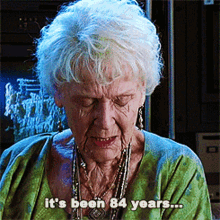
#kdrama#sbs one the woman#sbs wonder woman#jin seo yeon#jin seoyeon#honey lee#lee ha nee#lee sang yoon#lee won keun#park jeong hwa#kim young hoon#ocn tell me what you saw
3 notes
·
View notes
Text






1 note
·
View note
Text
“Do you want my jacket?”
Jumin glanced at you bundled cozily in your jacket. He had underestimated how cold it would get - nearing 100 degrees in the late afternoon, all he thought about at the time was ripping his jacket, vest and shirt from his body.
Now that the temperate had dropped significantly, he regretted ever thinking those things. Leaving his jacket over his chair, he believed the fresh night air would do him some good.
He shivered.
“Jumin ~?” You sang his name. “I see you shivering up there!”
“Keep your jacket on,” he encouraged, his warm breath meeting the chilly night air. “Driver Kim isn’t very far away now.” He arched his neck to look down the street. Of all nights, Driver Kim was running late.
Just as he moved to phone his chauffeur, a warm sensation slid over his shoulders and down his biceps.
“Damn, it’s cold!” You hissed, rubbing your arms.
“MC — what are you doing?” Jumin started to shed your coat off.
“Ah! Don’t you dare, you keep that thing on!” The adorable curve of your brow and downturn of your lip only showed that you meant business. “N-Now you know to wear your jacket at night, r-right?!”
Jumin stared at you, eyes darting over your face. The warmth in his heart radiated through his fingers and toes. He smiled, feeling much warmer than he did in the afternoon. “Come here.”
You skittered into his open arms, hugging him close and shaking off the remaining cold from your body. Jumin’s smile widened. “Holding you like this is the best defense against the cold.”
83 notes
·
View notes
Photo
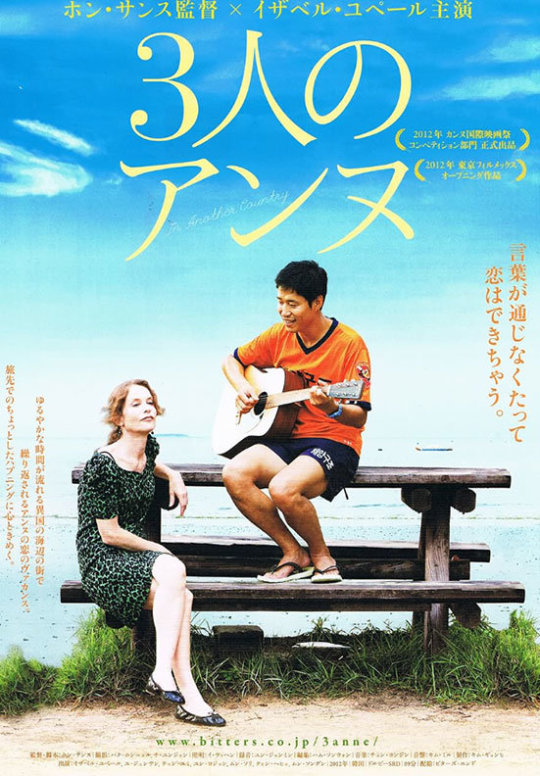
1.8.18 (6)
#watched#letterboxd#film#korean film#hong sang-soo#isabelle huppert#yoo jun-sang#kwon hae hyo#moon so ri#moon sung-keun#jung yu mi#youn yuh-jung#kim yong-ok#6#in another country
1 note
·
View note
Text
By clicking the source link, you will find 140 gifs of Lee Sang-hee in various television shows, movies, and interviews. Some of these projects included: End of Winter (2016), Our Love Story (2016), Children of the 20th Century (2017), Somewhere In Between (2020), All of Us Are Dead (2022), and Juvenile Justice (2022). All of the gifs were created by me from scratch. You may use these gifs to roleplay or as reaction gifs. Please do not repost or claim these gifs as your own. Contact me if you would like to edit these gifs for any purpose. I will likely say yes. Like or reblog if you find these gifs helpful!
Refer to the content warnings prior to clicking on the source link.
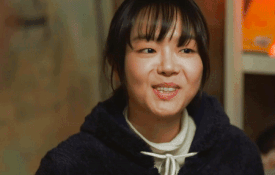
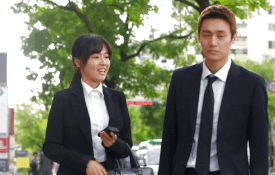
Content/trigger warnings: Food/eating, drinking/alcohol, zombies, injuries (e.g., getting bitten, neck wound, blood, body contortions), death, and text (e.g., on some gifs).
Featuring: Ryu Seon-young, Park Keun-rok, Lim Seong-mi, Han Ye-seul, Kim Ji-seok, Lee Sang-woo, Ahn Se-ha, Shin Sehwi, Shin Dong-mi, Lee Yoo-mi, Ham Sung-min, and Ryu Seon-young.
Notes: Lee Sang-hee is an actress and she is of South Korean descent, so please cast her accordingly. She is currently 38 years of age, but she was anywhere between the ages of 32 and 38 years old in the gifs included in this gif pack.
#lee sang hee#lee sang hee gif pack#rph#gif pack#gif hunt#gifpacknetwork#asian fc#korean fc#poc fc#poc gif pack#fc: lee sang hee#alissagifs
21 notes
·
View notes
Text
2020 Olympics South Korea Roster
Archery
Je-Deok Kim (Gyeongbuk)
Woojin Kim (Iwon)
Jin-Hyek Oh (Incheon)
San Ahn (Pyeongchang)
Min-Hee Jang (Seoul)
Chae-Young Kang (Gwangju)
Athletics
Wilson Erupe (Lodwar, Kenya)
Jong-Seop Sim (Seoul)
Byeong-Gwang Choi (Hwaseong)
Sang-Hyeok Woo (Seoul)
Min-Sub Jin (Busan)
Seulgi An (Seoul)
Kyung-Sun Choi (Seoul)
Badminton
Kwang-Hee Heo (Seoul)
Sol-Gyu Choi (Seoul)
Seung-Jae Seo (Buan)
Se-Young An (Gwangju)
Ga-Eun Kim (Gyeonggi-Do)
So-Yeong Kim (Incheon)
Hee-Yong Kong (Jincheon)
So-Hee Lee (Ulsan)
Seung-Chan Shin (Gochang-Gun)
Yoo-Jung Chae (Suwon)
Baseball
Won-Joon Choi (Seoul)
Woo-Suk Ko (Ganghwa-Gun)
Min-Woo Kim (Seoul)
Eui-Lee Lee (Gwangju)
Tae-In Won (Daegu)
Woo-Chan Cha (Gunsan)
Sang-Woo Cho (Uijeongbu)
Seung-Hwan Oh (Jeongeup)
Young-Pyo Ko (Gwangju)
Se-Woong Park (Daegu)
Jin-Uk Kim (Suwon)
Min-Ho Kang (Pohang)
Eui-Ji Yang (Gwangju)
Joo-Hwan Choi (Gwangju)
Kyoung-Min Hur (Gwangju)
Jae-Gyun Hwang (Seoul)
Baek-Ho Kang (Incheon)
Hye-Seong Kim (Seoul)
Jae-Il Oh (Guri)
Ji-Hwan Oh (Gunsan)
Hyun-Soo Kim (Seoul)
Jung-Hoo Lee (Gwangju)
Hae-Min Park (Seoul)
Kun-Woo Park (Seoul)
Basketball
Ji-Hyeon Sin (Seoul)
Lee-Seul Kang (Sacheon)
Ye-Bin Yoon (Boryeong)
Hye-Ji Ahn (Busan)
Hye-Jin Park (Busan)
Ji-Hyun Park (Seongnam)
Dan-Bi Kim (Bupyeong-Gu)
Hye-Yoon Bae (Seoul)
Jung-Eun Kim (Cheonan)
Min-Jeong Kim (Seoul)
Ji-Su Park (Seongnam)
Han-Byul Kim (Sacheon)
Boxing
Aeji Im (Hwasun-Gun)
Yeon-Ji Oh (Incheon)
Cycling
Ah-Reum Na (Naju)
Hye-Jin Lee (Geonggi)
Diving
Yeong-Nam Kim (Seoul)
Yeong-Taek Kim (Seoul)
Ha-Ram Woo (Busan)
Halim Kwon (Seoul)
Su-Ji Kim (Seoul)
Equestrian
Dong-Seon Kim (Seoul)
Fencing
Young-Jim Kweon (Iksan)
Segeon Ma (Seoul)
Sang-Young Park (Jinju)
Kwanghyun Lee (Seoul)
Bon-Gil Gu (Daegu)
Jung-Hwan Kim (Seoul)
Sang-Uk Oh (Daejeon)
Se-Ra Song (Seoul)
In-Jeong Choi (Geumsan)
Young-Mi Ko (Gwangju)
Hee-Sook Jeon (Seoul)
Soo-Yeon Choi (Ansan)
Ji-Yeon Kim (Busan)
Ji-Su Yoon (Busan)
Soccer
Bum-Keun Song (Seongnam)
You-Hyeon Lee (Gwangyang)
Jae-Woo Kim (Seoul)
Ji-Soo Park (Myungyeong)
Tae-Wook Jeong (Jeju)
Seung-Won Jeong (Jeonju)
Chang-Hoon Kwan (Seoul)
Kang-In Lee (Incheon)
Min-Kyu Song (Chungju)
Dong-Gyeong Lee (Seoul)
Dong-Jun Lee (Busan)
Young-Woo Seol (Ulsan)
Jin-Ya Kim (Daegun)
Dong-Hyun Kim (Seoul)
Du-Jae Won (Seoul)
Ui-Jo Hwang (Seongnam)
Won-Sang Um (Gwangju)
Joon-Soo Ahn (Uijeongbu)
Yoon-Sung Kang (Daegu)
Sang-Min Lee (Busan)
Changi An (Seoul)
Jin-Kyu Kim (Pohang)
Golf
Sung-Jae Im (Jeju Seom)
Si-Woo Kim (Seoul)
Jin-Young Ko (Seoul)
Park Inbee (Seoul)
Sei-Young Kim (Seoul)
Hyo-Joo Kim (Seoul)
Gymnastics
Jun-Ho Lee (Seoul)
Han-Sol Kim (Seoul)
Sung-Hyun Ryu (Seoul)
Hak-Seon Yang (Gwangju)
Jae-Hwan Shin (Jecheon)
Yun-Seo Lee (Seoul)
Seo-Jeong Yeo (Yongin-Si)
Handball
Yu-Ra Yung (Seoul)
Jun-Hui Jeong (Tongyeong)
Yun-Ji Kim (Seoul)
Kyun-Ming Kang (Seoul)
Hui Ju (Seoul)
Seon-Pil Won (Jeongseon)
Eun-Hee Ryu (Incheon)
Su-Min Choi (Seoul)
Hae-In Sim (Seoul)
Eun-Hye Kang (Seoul)
Ha-Rang Jo (Gwangju)
Mi-Gyeong Lee (Seoul)
Jin-Yi Kim (Taebaek)
Ji-In Jung (Busan)
Karate
Heejun Park (Busan)
Judo
Won-Jin Kim (Seoul)
Baul An (Anyang)
Shōrin An (Seoul)
Dong-Han Gwak (Pohang)
Gu-Ham Jo (Gangwon)
Min-Jong Kim (Seoul)
Yu-Jeong Kang (Yeosu)
Da-Sol Park (Seoul)
Ji-Su Kim (Seoul)
Hee-Ju Han (Seoul)
Seong-Yeon Kim (Gwangju)
Hyun-Ji Yoon (Seoul)
Mi-Jin Han (Seoul)
Pentathlon
Ung-Tae Jeon (Seoul)
Jin-Hwa Jun (Ulsan)
Se-Hee Kim (Seoul)
Sun-Woo Kim (Gyeonggi)
Rowing
Hye-Jung Jung (Seoul)
Rugby
Chang Yong (Seoul)
Jeong-Min Jang (Seoul)
Yon-Sik Jeong (Incheon)
Hyun Kim (Seoul)
Kun-Kyu Han (Seoul)
Nam Kim (Seoul)
Seong Lee (Seoul)
Won Park (Seoul)
Jin Lee (Seoul)
Andre Coquillard (Seoul)
Seong-Min Jang (Seoul)
Seong Choi (Seoul)
Gwong-Min Kim (Seoul)
Shooting
Dae-Yoon Han (Seoul)
Mo-Se Kim (Seoul)
Sang-Do Kim (Seoul)
Jong-Jun Lee (Seoul)
Jong-Oh Jin (Chuncheon)
Tae-Yun Nam (Seoul)
Jong-Ho Song (Seoul)
Eun-Young Cho (Seoul)
Ga-Eun Choo (Seoul)
Eun-Ji Kwon (Seoul)
Hee-Moon Park (Seoul)
Bo-Mi Kim (Seoul)
Min-Ji Kim (Ansan)
Min-Jung Kim (Seoul)
Climbing
Jongwon Chon (Seoul)
Chae-Hyun Seo (Seoul)
Swimming
Sungjae Cho (Seoul)
Seungwoo Moon (Seoul)
Yoo-Yeon Lee (Seoul)
Woo-Min Kim (Seoul)
Sun-Woo Hwang (Suwon)
Ju-Ho Lee (Asan)
Ho-Joon Lee (Gwangju)
Eunji Lee (Seoul)
Hyun-Young Jung (Seoul)
Da-Kyung Han (Gwangju)
Seo-Yeong Kim (Gyeonggi-Do)
Se-Hyeon An (Seoul)
Table Tennis
Woo-Jin Jang (Daejeon)
Young-Sik Jeoung (Seoul)
Sangsu Lee (Busan)
Ji-Hui Jeon (Seoul)
Yubin Shin (Seoul)
Hyo-Ju Choi (Busan)
Taekwondo
Jun Jang (Seoul)
Dae-Hoon Lee (Seoul)
Kyo-Don In (Incheon)
Jae-Young Sim (Seoul)
Ah-Reum Lee (Seoul)
Da-Bin Lee (Incheon)
Tennis
Soon-Woo Kwon (Sangju)
Volleyball
Eun-Jin Park (Seoul)
So-Young Lee (Asan)
Hye-Seon Yeom (Mokpo)
Hui-Jin Kim (Busan)
Hye-Jin An (Seoul)
Ji-Young Oh (Daegu)
Yeon-Gyeong Kim (Ansan)
Su-Ji Kim (Ansan)
Jeong-Ah Park (Seoul)
Hyo-Jin Yang (Busan)
Ji-Yun Jeong (Seoul)
Seung-Ju Pyo (Ulsan)
Weightlifting
Meong-Mok Han (Changwon)
Dong-Ju Yu (Jinan-Gun)
Yun-Seong Jin (Goyang)
Eunji Ham (Wonju)
Seon-Mi Lee (Gyeongsan)
Su-Hyeon Kim (Seoul)
Yeoun-Hee Kang (Seoul)
Wrestling
Han-Su Ryu (Busan)
Min-Seok Kim (Busan)
#Sports#National Teams#South Korea#Races#Kenya#Baseball#Basketball#Fights#Boxing#Animals#Soccer#Golf#Boats#Tennis
13 notes
·
View notes